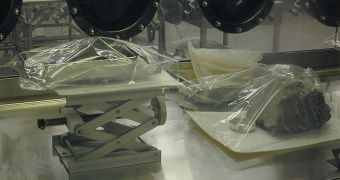A group of scientists from Australia announce that they have recently been able to figure out why lunar topsoil – the uppermost layer of soil – exhibits such unusual properties. They say that nanoparticles embedded inside small glass bubbles are responsible for these peculiar traits.
The study was conducted by a team of scientists at the Queensland University of Technology (QUT), under the supervision of soil scientist Dr. Marek Zbik, a member of the university's Science and Engineering Faculty.
Studies conducted on lunar soils samples returned by the Apollo missions have revealed the unusual behaviors these topsoils were capable of, but failed to investigate the origins and nature of nanoscale and microscale particles within these samples.
Zbik analyzed lunar soil by using a non-intrusive technique called synchrotron-based nano tomography, which is capable of revealing the structure of nanomaterials without damaging them. He had to travel to Taiwan to perform this study.
In essence, nano tomography is a type of transmission X-ray microscopy that enables experts to obtain 3D images of nanoparticles. “We were really surprised at what we found,” the QUT expert explains.
“Instead of gas or vapor inside the bubbles, which we would expect to find in such bubbles on Earth, the lunar glass bubbles were filled with a highly porous network of alien-looking glassy particles that span the bubbles' interior,” he goes on to say.
According to Zbik, these particles appear inside small bubbles of rock that melt when asteroids impact the Moon. When smaller meteorites hit the surface, during the fallout phase of cosmic collision, these bubbles are pulverized, releasing the nanoparticles.
“This continuous pulverizing of rocks on the lunar surface and constant mixing develop a type of soil which is unknown on Earth,” he goes on to say. Weirdly enough, the particles appear to respect the laws of quantum physics, which explains why we find their behavior peculiar.
“We don't understand a lot about quantum physics yet but it could be that these nano particles, when liberated from their glass bubble, mix with the other soil constituents and give lunar soil its unusual properties,” the QUT investigators go on to say.
Details of the new research effort were published in the latest issue of the esteemed journal International Scholarly Research Network Astronomy and Astrophysics.

 14 DAY TRIAL //
14 DAY TRIAL //